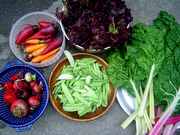

|
| Vegetable Varieties for Gardeners is a citizen science program
|
|
|
|
'Cowhorn' Potatoes |
| |
| Sub-Category: |
Late Season
|
| |
|
| Sub-Category 2: |
| | Description: |
Late-season. Fingerling tubers with pointed tips, dark-purple skin and dry, mealy, white flesh. Good storage. Excellent resistant to common scab and late bright.
|
| Days To Maturity: |
NA
|
| Seed Sources: |
|
| |
| Rating Summary |
| |
Overall: (4.5 Stars)
Taste: (1.5 Stars)
Yield: (0.5 Stars)
Ease/Reliability: (0.5 Stars) |
| |
| Reviews |
| |
Login to share your Review of Cowhorn.
Number of Reviews: 2
KEY: O=Overall Rating, T=Taste, Y=Yield, E=Ease
Reviewed on 08/26/2007 by
Luffa Zar
- An experienced gardener
|
 Overall Overall
 Taste Taste
 Yield Yield
 Ease Ease
|
Dane, Wisconsin, United States
Frost Free Season: 143 - 163 days
Soil Texture: Clay
Garden Size: Medium - 400 square feet to 1,600 square feet
Sun Exposure: 6 to 8 hours per day
|
| I havent had great luck with these, their a great looking tater. i grew them once and had poor yield, but want to grow them again and cant find the seed. |
| |
|
Reviewed on 03/19/2005 by
skiman
- An experienced gardener
|
 Overall Overall
Taste
Yield
Ease
|
Franklin, New York, United States
Frost Free Season: 103 - 123 days
Soil Texture: Loam
Garden Size: Large - More than 1,600 square feet (40' x 40')
Sun Exposure: More than 8 hours per day
|
| Cowhorn is also known under the synonyms Purple Cowhorn, Purple Cow Horn and Seneca Cowhorn, but is apparently separate from and different than a variety called Seneca Horn. Though often listed as a fingerling in most databases, Cowhorn is not a true fingerling potato. Its name comes from its shape being similar to a cow's horn. The tuber is oblong, thickest at the far (apical) end, and curved as a cow's horn, to a narrow end at the stem attachment. Skin is dark purple; flesh is cream-colored. Eyes are shallow and few in number. It has large spreading plants. It is valued as a 'quick bake' baking potato. Specific gravity is 1.069, making it moist (waxy) when baked. Maturity is mid-to-late, and it is low yielding. Cowhorn is a heritage variety with uncertain origins. It has been grown in New York state since before 1848. There is some speculation that it might have been developed in Vermont. There is further speculation that it might be identical to La Crotte d\'Ours (Bear Poop), a Canadian heritage variety thought to have roots to Scotland. La Crotte d\'Ours tubers may well have flesh streaked with purple making them quite distinct from Cowhorn. DNA analysis may be required to straighten this out.
|
| |
|
|
|
|
Vegetable Varieties for Gardeners is a citizen science program, © 2004-2024, All Rights Reserved
Cornell Garden Based Learning, Cornell University College of Agriculture & Life Sciences, Horticulture Section
|




 VVfG home
VVfG home
 Overall
Overall Taste
Taste Yield
Yield Overall
Overall